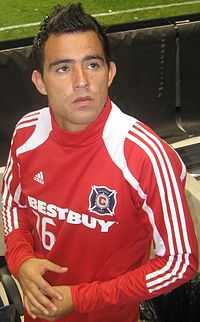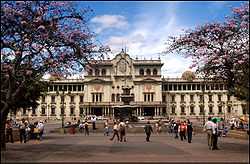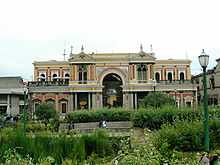Italian Guatemalan
Italians in Guatemala or Italian Guatemalans is a continuation of the Italian diaspora that started over two centuries ago in the Americas. Many have descendants in the country. The Italians contributed in the construction of the country as monuments, parks and besides contributing at the National Conservatory.
History
The history of Italian immigration in Guatemala comprises three periods of migratory waves from the 19th and 20th centuries,[1] and the majority of these immigrants settled in Quetzaltenango, but there were also significant communities in Guatemala City and Zacapa. This Italian influence can be seen in various buildings in the country.
Notable Italian-Guatemalans
- Stefano Cincotta, is a Guatemalan footballer who plays for Germany.
- Juan Jose Gerardi Conedera, was a Guatemalan Roman Catholic bishop and human rights defender.
- Marco Pappa, is a Guatemalan footballer who plays for the MLS club Seattle Sounders FC. He is a member of the Guatemala national team.
- Dwight Pezzarossi, is a retired professional football forward who last played for Comunicaciones in the Liga Nacional de Guatemala.
Italian culture in Guatemala
The Guatemala National Palace was built in the government of
Jorge Ubico, and performed with various Italian designs, owing to the Italian influence in the country
Pasaje Enríquez, by Italian architect Alberto Porta
There is much Italian cultural influence in Guatemala, especially evident in the buildings and architecturual styles of earlier times, the Italians contributed in the construction of the country as monuments, parks and besides contributing at the National Conservatory such as National Palace of Guatemala, various catholic churches or the arch of Quetzaltenango. There are institutes that teach Italian in Guatemala,[2] as well as people in Guatemala with Italian surnames such as Bocaletti, Garzaro, Bonnato, Maselli, Comparini, Scoteti and others.[1] A number of Italian architects arrived in Guatemala towards the end of the 19th century, giving rise to an Italian-influenced art and architectual movement, particularly in the capital, and several Italian architects oversaw construction projects in Quetzaltenango; these included the Templo de Logia Fénix No. 2, by Alberto Porta.[3] A group of Italian architects, including Porta and Luigi Lutti, with sculptor Desiderio Scotti, founded the Academy of Municipal Architecture, and were responsible for building many of the most prominent buildings in Quetzaltenango, including the Banco del Occidente and Pasaje Enríquez.[4]
See also
References
 Ethnic groups in Guatemala |
|---|
| | Guatemalan Indians | |
|---|
| | Guatemalan mestizo | |
|---|
| | Descendants of Europeans (whites or Criollos) | |
|---|
| | Descendants of Asians | |
|---|
| | Descendants of African slaves | |
|---|
| | Recently immigration | |
|---|
|
|
|---|
| | By Country | Africa | |
|---|
| Americas | |
|---|
| Asia | |
|---|
| Europe | |
|---|
| Oceania | |
|---|
| |
|---|
| | See also | |
|---|
| 1 former Italian colonies and protectorates |
|



